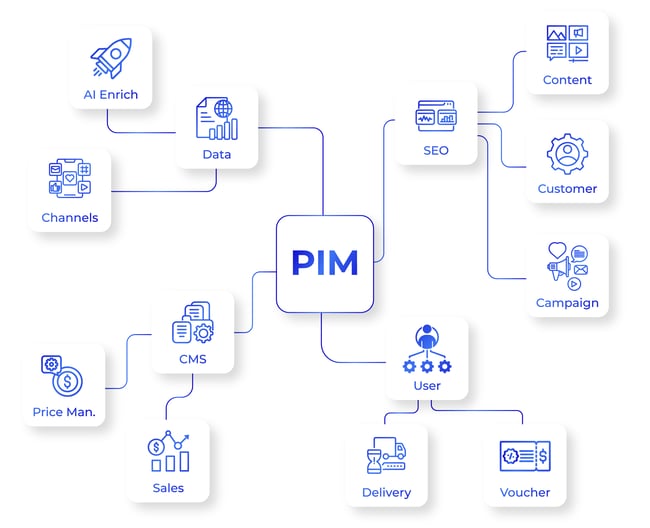Most e-commerce businesses are familiar with the basics of Product Information Management (PIM): centralise product data, cleanse it, and syndicate it across your sales channels.
However, if you are still reliant on a rigid, all-in-one system, you are likely working far harder than necessary and missing out on the true potential of a modern, composable PIM.
Here are three standout capabilities a composable PIM can offer that legacy, monolithic platforms simply can not match:
1. Integrate with Any Tool
E-commerce technology stacks are rarely uniform. You use one platform for your shop, another for CRM, a third for DAM, and several others. Integrating all these systems can be overwhelming unless you use a composable, API-first PIM.
Composable PIMs are designed for connectivity. Bluestone PIM’s MACH-certified architecture (Microservices-based, API-first, Cloud-native, Headless) lets you connect to any existing or future tool, from your CMS to your digital marketplaces.
-
Swap tools painlessly: Replace or upgrade any component (syndication, media management, analytics) without impacting the rest of your stack.
-
Avoid vendor lock-in: Build a tech ecosystem that evolves with your business.
What you can’t do elsewhere: Monolithic PIM suites force you to keep bundled features. Changing one component disrupts your entire system.
Composable advantage: Each Bluestone PIM function runs independently, ensuring upgrades, scaling, or replacement are seamless and risk-free.

2. Launch New Sales Channels in Days, Not Months
Say you want to start selling on a new marketplace. Or launch a separate catalogue for a new region. Or even just create a tailored experience for your B2B buyers. In a typical setup, that means weeks — or even months — of planning, mapping, and fixing data.
With a composable PIM, that is no longer the case.
You can syndicate your product data to any new channel with minimal effort. Whether it is a mobile app, a new regional storefront, or a B2B portal, simply set the right product structure and push. Bluestone PIM lets you manage multiple catalogues, create channel-specific content, and localise everything from a single place.
That means you get to market faster. And in e-commerce, speed is often the difference between leading and falling behind.
What you can’t do elsewhere: Legacy systems treat every new channel as a bespoke project. That means hardcoded integrations, manual data mapping, and a long list of things that can go wrong.
Composable advantage: With Bluestone PIM’s Extension Hub you can instantly plug into new marketplaces, storefronts, or regional portals. You can tailor the feed, structure, and language for each channel while still managing everything centrally.
Watch the video to find out when going composable is the right move for your business.
3. Automate and Personalise Product Content at Scale
Managing product data at scale does not have to be slow, manual, or generic if you are using a composable PIM.
Thanks to its flexible data modelling and AI-agnostic architecture, Bluestone PIM makes it easy to automate enrichment, localisation, and personalisation workflows.
With built-in AI features in your PIM, you can handle all the repetitive content work in a fraction of the time:
-
Generate product descriptions in bulk
-
Translate content across dozens of markets
-
Tweak tone and style
-
Set clear instructions to keep everything on-brand
-
Review and score results to maintain quality across the board
What you cannot do elsewhere: Legacy PIMs often rely on manual input or semi-automated scripts to update and syndicate data. Personalising content by market, persona, or language quickly becomes inefficient and error-prone.
Composable advantage: Bluestone PIM integrates with AI tools for bulk translation, dynamic enrichment, and personalised product content generation across all touchpoints like web, mobile, POS, or marketplace.
Save Time and Stay Consistent with AI Templates
And to make all this even more efficient, you can use AI Templates.
These allow you to save your best AI setups, such as prompts, rules, tone of voice, content types, and preferred languages, so you can reuse them whenever needed.
Whether it is product descriptions, translations, or data analysis, your team does not have to start from scratch each time.
You can customise everything, from input fields to tone and language preferences. Duplicate or edit templates as required, and even organise them by use case or region.
Should You Move to a Composable PIM?
Composable PIM offers a new way to manage product data: flexible, fast, and ready for whatever comes next. While others are tied to clunky systems and endless spreadsheets, you could be launching new channels, expanding globally, and delivering a consistent product experience across every touchpoint.
If your current system makes simple things difficult, perhaps it is time to go composable.
Talk to our team or book a demo to see how Bluestone PIM can work for you.